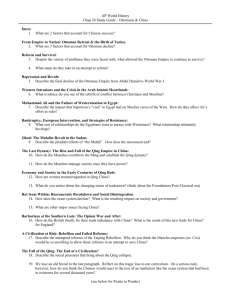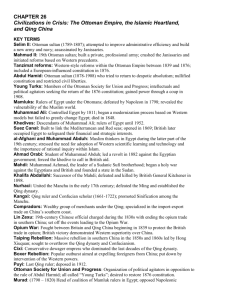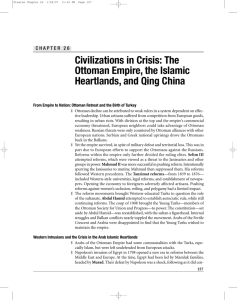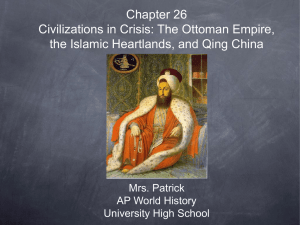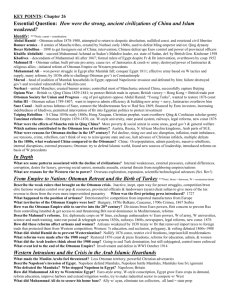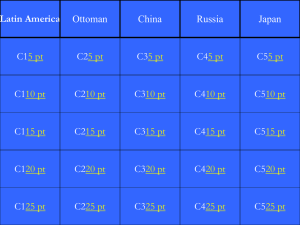Chapter 26, Civilizations in Crisis
advertisement
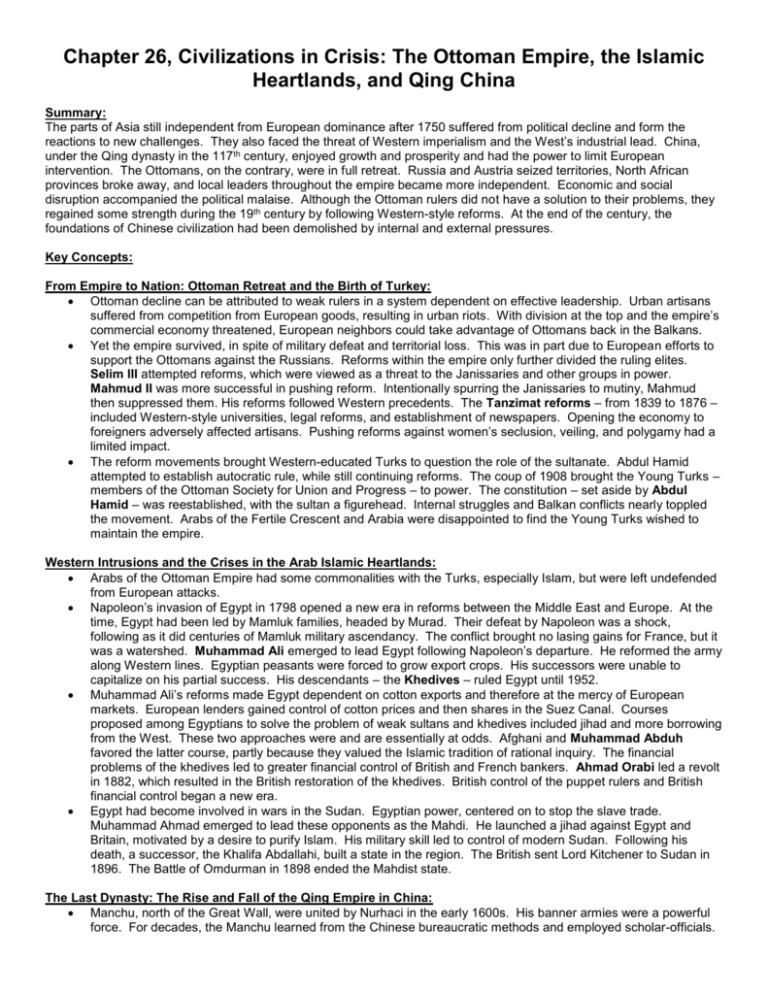
Chapter 26, Civilizations in Crisis: The Ottoman Empire, the Islamic Heartlands, and Qing China Summary: The parts of Asia still independent from European dominance after 1750 suffered from political decline and form the reactions to new challenges. They also faced the threat of Western imperialism and the West’s industrial lead. China, under the Qing dynasty in the 117th century, enjoyed growth and prosperity and had the power to limit European intervention. The Ottomans, on the contrary, were in full retreat. Russia and Austria seized territories, North African provinces broke away, and local leaders throughout the empire became more independent. Economic and social disruption accompanied the political malaise. Although the Ottoman rulers did not have a solution to their problems, they regained some strength during the 19th century by following Western-style reforms. At the end of the century, the foundations of Chinese civilization had been demolished by internal and external pressures. Key Concepts: From Empire to Nation: Ottoman Retreat and the Birth of Turkey: Ottoman decline can be attributed to weak rulers in a system dependent on effective leadership. Urban artisans suffered from competition from European goods, resulting in urban riots. With division at the top and the empire’s commercial economy threatened, European neighbors could take advantage of Ottomans back in the Balkans. Yet the empire survived, in spite of military defeat and territorial loss. This was in part due to European efforts to support the Ottomans against the Russians. Reforms within the empire only further divided the ruling elites. Selim III attempted reforms, which were viewed as a threat to the Janissaries and other groups in power. Mahmud II was more successful in pushing reform. Intentionally spurring the Janissaries to mutiny, Mahmud then suppressed them. His reforms followed Western precedents. The Tanzimat reforms – from 1839 to 1876 – included Western-style universities, legal reforms, and establishment of newspapers. Opening the economy to foreigners adversely affected artisans. Pushing reforms against women’s seclusion, veiling, and polygamy had a limited impact. The reform movements brought Western-educated Turks to question the role of the sultanate. Abdul Hamid attempted to establish autocratic rule, while still continuing reforms. The coup of 1908 brought the Young Turks – members of the Ottoman Society for Union and Progress – to power. The constitution – set aside by Abdul Hamid – was reestablished, with the sultan a figurehead. Internal struggles and Balkan conflicts nearly toppled the movement. Arabs of the Fertile Crescent and Arabia were disappointed to find the Young Turks wished to maintain the empire. Western Intrusions and the Crises in the Arab Islamic Heartlands: Arabs of the Ottoman Empire had some commonalities with the Turks, especially Islam, but were left undefended from European attacks. Napoleon’s invasion of Egypt in 1798 opened a new era in reforms between the Middle East and Europe. At the time, Egypt had been led by Mamluk families, headed by Murad. Their defeat by Napoleon was a shock, following as it did centuries of Mamluk military ascendancy. The conflict brought no lasing gains for France, but it was a watershed. Muhammad Ali emerged to lead Egypt following Napoleon’s departure. He reformed the army along Western lines. Egyptian peasants were forced to grow export crops. His successors were unable to capitalize on his partial success. His descendants – the Khedives – ruled Egypt until 1952. Muhammad Ali’s reforms made Egypt dependent on cotton exports and therefore at the mercy of European markets. European lenders gained control of cotton prices and then shares in the Suez Canal. Courses proposed among Egyptians to solve the problem of weak sultans and khedives included jihad and more borrowing from the West. These two approaches were and are essentially at odds. Afghani and Muhammad Abduh favored the latter course, partly because they valued the Islamic tradition of rational inquiry. The financial problems of the khedives led to greater financial control of British and French bankers. Ahmad Orabi led a revolt in 1882, which resulted in the British restoration of the khedives. British control of the puppet rulers and British financial control began a new era. Egypt had become involved in wars in the Sudan. Egyptian power, centered on to stop the slave trade. Muhammad Ahmad emerged to lead these opponents as the Mahdi. He launched a jihad against Egypt and Britain, motivated by a desire to purify Islam. His military skill led to control of modern Sudan. Following his death, a successor, the Khalifa Abdallahi, built a state in the region. The British sent Lord Kitchener to Sudan in 1896. The Battle of Omdurman in 1898 ended the Mahdist state. The Last Dynasty: The Rise and Fall of the Qing Empire in China: Manchu, north of the Great Wall, were united by Nurhaci in the early 1600s. His banner armies were a powerful force. For decades, the Manchu learned from the Chinese bureaucratic methods and employed scholar-officials. Called in to help put down a rebellion, they instead took Beijing. Under the dynastic name Qing, they ruled China. The Manchu elite ruled with few changes to court or bureaucratic procedure. They patronized traditional Chinese arts and Confucianism. Kangxi was himself an important Confucian scholar. Minimal changes occurred in Chinese society under the Manchu, except possibly a decline in the status of women. Rural reforms attempted to bring more land into cultivation and restore the infrastructure of dikes, roads, and irrigation. These improvements were partially successful, yet did little to mitigate the power of landlords. Merchants did well under the Qing as exporters of tea and silk. These compradors linked China to the rest of the world. Qing decline went along familiar lines. The examination system ceased to fill its role in bringing forward able administrators. Posts could be bought, and cheating was allowed. The abuses were troubling in a system based on Confucian education, intended to engender concern for the people of China. Again, public works in rural areas were abandoned. In the Shangdong peninsula, the Huanghe River was allowed to flood. Thousands died from famine and disease. Banditry, on the rise, signaled a weakening dynasty. Many expected that a new dynasty would now renew the historical cycle. Yet the new “barbarians” threatening China could not be sinified and absorbed. In the 18 th century, British merchants had turned to opium for export to China. British depended on the trade, but the Chinese saw it as a threat. As much as one percent of the Chinese were addicted, causing widespread social and administrative problems. Efforts to stop the trade began in the 1820s. In the 1830s Lin Zexu was sent to end the opium trade. To do so he confiscated opium, destroyed warehouses, and imposed a blockade. The resulting Opium War ended with Chinese defeat. China was forced to open its ports to foreign trade. Hong Kong was developed as a British outpost. British officials oversee Chinese trade, and the government was forced to accept foreign ambassadors. Chinese defeat and growing foreign interference led to revolts. The Taiping Rebellion was led by Hong Xiuquan against the Zing. Although successful militarily, the movement fell apart, especially under British opposition. The Taiping Rebellion challenged not just the Qing government, but also the traditional order. The scholar-gentry thus rallied to the regime. Men such as Zeng Guafan led the self-strengthening movement against Western influence, while embracing Western technology. Manchu attempts at reform were blocked by those resistant to change, such as the dowager empress Cixi. In 1901, the Boxer Rebellion tried to expel foreigners. It resulted in greater European control. Numerous secret societies formed to end Qing rule, without success. Yet they spawned a succeeding generation of reformers, such as Sun Yat-sen. These revolutionaries targeted foreigners. In 1911, they forced the Manchu from power. The revolution ended the Qing dynasty. In 1905, the civil service exams had been discontinued, after 2,500 years. Key Terms: Selim II Mahmud II Tanzimat reforms Abdul Hamid Young Turks Mamluks Muhammad Ali (Egypt) Khedives Suez Canal Al-Afghani and Muhammad Abduh Ahmad Orabi Mahdi Khalifa Abdallahi Nurhaci Kangxi Compradors Lin Zexu Opium Wars Taiping Rebellion Cixi Boxer Rebellion Puyi Ottoman Society for Union and Progress: Murad Khartoum Muhammad Achmad Banner armies Qing Dynasty Hong Xiuquan Jihad Treaty of Nanjing General Kitchner Suez Canal Essay Questions: Civilizations in Crisis: The Ottoman Empire, the Islamic Heartlands, and Qing China 1. How did the emergence of the industrialized West affect the pattern for the decline of civilizations? 2. How did the experience of the Qing dynasty in China and the Ottoman Empire differ between 1700 and 1900? 3. Compare and contrast the conditions leading to the overthrow of the Ottoman Empire in 1908 and the Qing dynasty in 1912. 4. Compare and contrast the British intervention in Egypt with its intervention in China. 5. Contrast the reactions of the Islamic heartlands and China to the challenge of the West.
